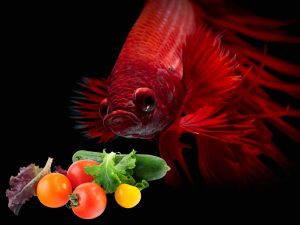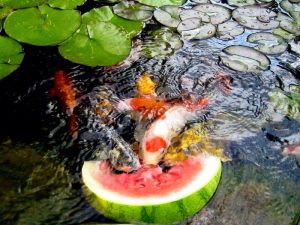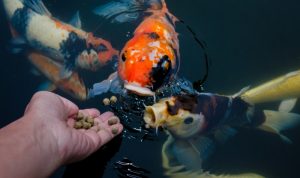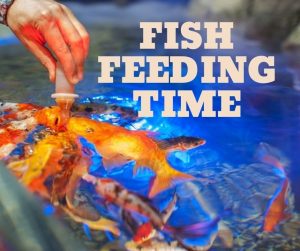If you have a pet fish, chances are you are feeding them packaged fish food. Even though store-bought fish food is not hazardous to your pet’s health, they contain preservatives that are best not consumed.
You don’t necessarily have to be a health enthusiast. Sometimes you can even run out of store-bought food. In all of these scenarios, we have got you covered.
If you want to feed your fish a natural diet, you are in the right place.
Here is everything you need to know about alternative fish food and the different options you can find in your pantry.
What Happens When to Fish without Fish Food
Pet fish can survive up to 7 days without food. Some species can also survive up to 14 days without being fed.
Meanwhile, these fish will consume aquarium algae to fulfill their nutritional requirements.
This, however, should not be done on purpose. Leaving your pets unattended and poorly fed is not only unethical but can cause serious diseases in your pet fish.
You need to feed your fish daily or on an alternate day basis in small pieces without compromising nutrition.
| Photo | Title | Price |
|---|---|---|

|
Tetra 77080 Pro Tropical Color Crisps | Check Pricing |

|
Kaytee Koi's Choice Koi Floating Fish Food | Check Pricing |

|
Aqueon Tropical Flakes | Check Pricing |

|
Blue Ridge Fish Food | Check Pricing |

|
TetraPond Variety Blend, Pond Fish Food, for Goldfish and Koi Yellow 2.25 Pound (Pack of 1) | Check Pricing |
Popular Fish Food Alternatives
This article will discuss everything you need to know about alternative fish food. Whether you can get it from your fridge or pantry, we will discuss everything in detail.
There can be several reasons why you need alternative fish food. If you want to switch to a healthier alternative or simply have no fish food stock, then this guide is for you.
What Do You Feed a Fish If You Have No Fish Food?
If you are out of fish food, don’t worry, you won’t starve your fish to death. There are other things that you can feed your fish that are healthier than store-bought food. Each kind of fish is different and has different nutritional requirements.
Some need a vegetarian diet, some need meat, while others require both. However, most fish owners opt for store-bought ease because it is easier than making gourmet meals for your pets.
Whether you go for dried pellets, wafers, flakes, or live food, there is always a homemade alternative for that. These alternatives will not only be more nutritional, but you will also find your fish to be more interested in mealtimes because of the fresh taste.
However, before you start giving your fish home alternative fish food, you should consult a professional aquarist.
You should be well-informed about your pet’s nutritional needs to avoid deficiencies.
Can I Use Homemade Fish Food?

Even though most excerpts suggest sticking to store-bought fish food because they are designed to survive in the water for longer. In addition, they don’t easily contaminate the water while your pet fish can feast on the palettes, flakes, etc.
However, if you take extra care of the aquarium, you can use several homemade alternatives for your pet fish. There are several recipes you can go for if you don’t have industrial fish feed at hand.
Yes, it is entirely safe to use homemade fish food. You can give a homemade fish diet to all kinds of fish without a doubt.
Even if you are a beginner, you can follow a few precise recipes to make a perfectly balanced meal for your fish.
What Human Food Can Fish Eat?

Yes, human beings cannot eat fish food, but fish can eat certain human foods. For example, most fish can consume vegetables, fruits, rice, and poultry.
However, fish who are more familiar with the aquarium fish feed can have a hard time digesting it.
If you want to stick to a plant-based fish diet, opt for fruits and vegetables only. Seaweed is also a good option for your herbivores or omnivores.
However, it is important to have protein-based food options for carnivores and omnivores.
If your fish is not familiar with human foods, they will need some time to adjust to the change. So, make sure not to change your decision after one or two feedings.
Rice
Rice is one of the staple grains in the human diet. It can also be great alternative fish food. Rice has vitamin B, fiber, potassium, and iron that will fulfill your pet fish’s nutritional requirements.
Giving your fish a diet that only consists of cooked or uncooked rice can cause deficiency. So, make sure to pair boiled rice with other proteins and vegetables for a balanced meal.
You can break the rice in a mortar and pestle for smaller fish and boil them in unsalted water.
Fish Filet
Yes, this might sound confusing, but bigger fish can eat smaller fish. Most carnivore fish like to eat fish to get the protein their body needs. Oscars are one of the most common aquarium fish that eat other fish.
They get protein and other vitamins and minerals from eating smaller, softer fish. Apart from fish, boiled shrimp can also be a great addition to a carnivore fish diet.
Chicken
Another meat option for fish is small chunks of chicken. It is also a great source of protein and Vitamin B12.
Especially the carnivore and omnivore fish that look deficient or do not eat properly need to have an occasional chicken-based meal.
It will provide ample nutrition to your fish for a long period. However, this should not be a part of their everyday diet as it is quite hard to digest.
Beef is also something that their stomachs cannot digest. So whether it is beef filet, beef hearts, or any other organ meat, it can be hazardous for their health.
Eggs
Omnivore fish depend on boiled eggs for their protein intake. It is a good source of protein and other vitamins to keep your fish healthy.
You can cut the egg into small pieces to feed them as occasional treats.
Avoid giving them raw eggs as they can find it hard to digest. Raw eggs contain a protein called avidin that can inhibit the growth of your fish.
Too much egg can cause fat build-up in their system, leading to diseases. Make sure to clean the tank thoroughly after feeding eggs to your fish, as it can quickly make your tank smell foul.
Barley
So, can fish eat bread? Yes, they surely can if it’s made from barley.
Barley is not something that you conventionally find in fish food. However, it can be excellent alternative fish food for commercial fish.
Scientists have recently created a barley protein concentrate that can be a great food option for trouts and other commercially grown fish.
It will fulfill the protein requirement without feeding them any kind of meat. Barley is also rich in fiber and vitamin B1, which will help them grow healthier. It can be a great part of a carnivore fish diet.
What Vegetables Can Fish Eat?

You’ll be surprised to know that fish can eat many different vegetables. Most regular fish munch on small flakes of vegetables that will not contaminate the aquarium water.
If you are thinking of switching to plant-based alternative fish food, then keep reading.
Here are some common vegetables that you can replace the normal fish food with:
Lettuce
Lettuce is one of the most common greens you can introduce to your fish. They can eat raw or steamed lettuce, depending on their size. Herbivore and omnivore fish can have lettuce any time of the day in small portions.
Sprouts
Boiled sprouts can also be a great addition to herbivore fish diets. They provide almost the same micronutrients as algae, which is a great alternative fish food for marine vegetarian fish.
Peas
Boiled peas that are crushed or ground are another alternative fish food. You can also use it as a top feed if they are raw. Herbivore fish love to eat fresh peas. Smaller fish may find it hard to digest raw peas, so make sure to boil them accordingly.
Spinach
Spinach is a great source of protein and iron in herbivore fish. Some fish can be allergic to this kind of green vegetable, so it is best to check it beforehand. You can use Blanched spinach to feed your fish.
Cucumber
Blanched cucumbers are also another alternative fish food for herbivore fish. They are a great source of vitamin C and vitamin K. Although cucumber seeds can be dangerous for most fish.
What Fruits Can Fish Eat?

Apart from fruits, herbivore and omnivore fish can also eat fruits. Fruits can add a lot of nutritional benefits to their diets. They can eat fruits raw in small pieces without having any trouble with digestion.
Here are some everyday fruits that work as great alternative fish food:
Apples
Finely chopped apples without skin are also great for herbivore and omnivore fish. It is high in vitamins, minerals, and antioxidants. However, since apples are sweet, some fish might not prefer eating them.
Bananas
Small pieces of banana are great for adding a boost of minerals to your fish’s diet. The mushy fruit can mess up the aquarium water. Therefore, it is best to only serve this as a treat occasionally.
Melons
Fish love eating melons. They are rich in fiber, minerals, and vitamin C. Small cubes of different melons are a healthy alternative fish food as they provide several health benefits.
Grapes
Another source of antioxidants with countless minerals and vitamins in grapes. Finely chopped grapes are an occasional nice treat for fish. Since they are soft, most small fish prefer eating grapes.
Papaya
Papaya is packed with enzymes to aid their digestion. Small pieces of papaya can be a great addition to their diet, along with other fresh fruits and vegetables. It will promote better gut health and promote growth.
Differences Between Meat-Eating vs. Vegetarian Fish

This is pretty much self-explanatory. Meat-eating fish consume meat, and vegetarian fish consume a plant-based diet.
Parrotfish, Achilles black-spot, Bloch, Silver dollar fish, Mollies, Swordtails, and green sea turtles are herbivores. In contrast, Tetra, Betta, Arowana, Pufferfish, Cichlid, Killifish, and butterflyfish are meat-eating species.
It is important not to force meat-eating fish to have a plant-based diet as it can adversely impact their digestion. Similarly, vegetarian fish do not have enzymes to dissolve meat particles, so feeding a carnivore diet can cause severe diseases or death.
What Can Omnivores Eat?
Omnivore fish can eat a plant-based diet and a meat-based diet. They need both kinds of fish food items to maintain a healthy and balanced system. These fish species are rather easier to feed.
What Do Carnivores Want to Eat?
Carnivore fish eat a meat-based diet that includes crustaceans, insects, and other small fish. They do not eat plants, whether normal vegetables and fruits or marine plants.
What Do Herbivores Eat?
Herbivore fish only feed on plants. Whether it is a normal vegetarian diet or seaweed and algae, they only have plant matter. Their stomachs cannot digest any meat or flesh-based protein.
What Should You Feed Your Fish?

There are several kinds of alternative fish food to feed your fish. If you want to know what you feed your cats other than store-bought fish food, then keep on reading.
Live Food
Live food includes insects and worms to give your fish all the essential nutrients in one meal. It might feel a bit queasy, but if you want to give your fish a nutrition-filled diet, live food is the best option to go for.
If you have a carnivore or omnivore fish, their diet should include live food. Blood worms, mealworms, mosquito larvae, waterbugs, and sludge worms are some of the most common live food options for aquarium fish.
Back in the day, aquarists relied on live food to feed their fish. However, this kind of food can easily introduce different diseases in the fish tank water.
Fresh
Many people also feed fresh food like vegetables, fruits, and rice to fish. Whether they are freshwater fish or marine water fish, they can easily eat fresh food. Vegetables like cucumbers, lettuce, sprouts, peas, zucchini, and spinach are ideal for herbivore and omnivore fish.
They can also eat melons, bananas, papayas, apples, mangoes, and grapes. Freshwater live aquarium plants are also considered fresh food for your herbivore fish.
Before you feed fresh vegetables and fruits to your fish, make sure to thoroughly research the fish species you have and their nutritional requirements. Do not force feed plant matter on carnivorous fish.
| Photo | Title | Buy |
|---|---|---|

|
MyLifeUNIT Aquarium Plants, 20 Pack Artificial Fish Tank Plants for Aquarium Decorations (Green) | Check Pricing |

|
Florida 10 Species Live Aquarium Plants Bundle | Check Pricing |

|
10 Species Live Aquarium Plants Package - Microsorum Java Fern, Swords, Vallisneria and more! | Check Pricing |

|
Java Fern and Anubias Bundle | Check Pricing |
Freeze-Dried
If you want to go for live food for your fish but store them for a long time, then you can try freeze-dried food. Freeze drying food also minimizes the undesirable bacteria and other microorganisms in the worms and insects.
You can find freeze-dried blood worms, brine shrimp, daphnia, blackworms, and sludge worms online or at your local pet store. These can be quite a nutritious alternative to fish food.
Freeze-dried food is the best option for people who cannot grab fish food from their local pet store now and then. They can be stocked for an extended period because of their long shelf life.
You can break it into tinier pieces to feed small fish.
| Photo | Title | Buy |
|---|---|---|

|
Hikari Bio-Pure Freeze Dried Blood Worms for Pets, 0.42-Ounce | Check Pricing |

|
Tetra BloodWorms 0.28 Ounce, Freeze-Dried Food For Freshwater and Saltwater Fish, 0.28-Ounce, 100-Ml | Check Pricing |
Dry Food
Dry food is the most common option among pet fish owners. They are easily available and have a long shelf life. There are several flavors and types available in dry food.
The different types of dry fish food are flakes, crisps, pellets, granules, wafers, and tablets. They are ideal for top-feeding your pet fish, depending on the kind of fish you have.
Most aquarium fish love dry food as they stay longer in the water without disintegration.
Dried flakes are the best option for freshwater fish as they are lightweight and easy to digest. They also don’t contaminate the water quickly.
| Photo | Title | Buy |
|---|---|---|

|
Tetra TetraMin Plus Tropical Flakes 2.2 Ounces, Nutritionally Balanced Fish Food, With Added Shrimp | Check Pricing |

|
Fluval Bug Bites Tropical Fish Food, Small Granules for Small to Medium Sized Fish, 1.6 oz., A6577 | Check Pricing |

|
Tetra PRO PlecoWafers 5.29 Ounces, Nutritionally Balanced Vegetarian Fish Food for Bottom Feeders, Concentrated Algae Center | Check Pricing |

|
Omega One Freshwater Flakes, 5.3 oz | Check Pricing |
How Much and How Often Should You Feed Your Fish?

As a general rule of thumb, it is best to feed your aquarium fish once daily. Most aquarium fish can go a week without food, so regular feeding is not necessary.
However, some fish have special nutritional requirements, which means they need two feedings per day. If you are feeding your fish twice a day, it should be light and easily digestible.
Avoid Overfeeding the Fish
Experts strictly advise against overfeeding a fish. It is better to underfeed a fish than overfeed as they can spend days without food.
Overfeeding can cause the accumulation of waste in their body, resulting in their death. It is one of the most common reasons for pet fish loss. Therefore, having a proper feeding schedule for your fish is important.
If Your Fish Is Not Eating
Inappropriate Feed and Overconsumption
Amateur hobbyists may buy food alternatives without reading the labeling or considering their fish’s preferences.
Fresh and marine fish have distinct diets and nutritional requirements. Plus, even within the same group, various species may have different nutritional needs. Therefore, make sure you’re feeding your fish proper food and that their nutrition is balanced.
Second, check to see if the food your fish will eat has gone rotten. For this, you may check the expiration date and discard it if it has passed.
Pellets and flakes might go bad sooner than intended if you don’t store them in the proper vessel or at the proper temperature.
If you store your feed in a moist and warm place, such as over a stove the food will decay quicker, and the fish will suffer as a result. Furthermore, some fishes aren’t picky about their food options and will eat most things easily. Thus, it is your responsibility to ensure healthy food sources for them.
Inappropriate Environment
Fish are very sensitive organisms that detect changes in water factors very fast. Thus, changes in pH, hardness, and carbon dioxide or phosphate levels might cause the fish to cease feeding.
A major pH discrepancy can harm your fish if you don’t detect and remedy it.
As a result, it’s crucial to assess the water quality parameters with a testing apparatus on a regular basis. Moreover, Ammonia is a component of fish urine. Also, decaying materials in the tank, such as plant leaves, or leftover food, can emit large volumes of ammonia, nitrite, and nitrate.
If these substances accumulate in the aquarium, the fish becomes increasingly uncomfortable and may stop eating. Hence, it’s not always a case of unclean water.
Unsuitable Temperature
Fish, unlike humans, cannot adjust their internal temperature. Therefore, they rely on the temperature of the water to keep them steady. Further, every fish is distinct, thus each one can survive only in a specific temperature range.
Accordingly, you must choose fish from comparable habitats for a group tank so that you can give the optimal environment for all of them.
Plus, sustaining the temperature without a heater may be difficult, especially if you live in an area where the weather becomes too cold in the winter.
When the temperature falls below the fish’s comfort level, its metabolism becomes lethargic. Consequently, this will make it appear full when it is not.
As an outcome, your fish will become indolent and sluggish, and they will accidentally starve themselves. However, if your aquarium becomes scorching, your fish may become restless at first. Next, as the oxygen levels decrease the fish will eventually suffocate.
Stress
If your fish is a newbie, it may be terrified of the unfamiliar surroundings. In this scenario, refusing to eat is natural.
After it adjusts to its new surroundings, it should begin eating.
A newcomer might sometimes stress out the existing residents, but if the newcomer is quiet and docile, they will be calm about it.
Another possible source of stress is a lack of hiding places. Therefore, give your fish enough space to hide out and be on their own.
Final Thoughts
There are several alternative fish food that you can source directly from your pantry. From rice, eggs, chicken, and fish filet to fresh fruits and vegetables, you can feed your fish a variety of food options.
Finding alternative fish food is important, especially to feed your fish in case of an emergency. It also brings a nice change in their routine. Hence, it’s absolutely right to ask yourself “what can guppies eat besides fish food”?
Homemade fish food is not only delicious but also essential for the proper growth of your fish.

